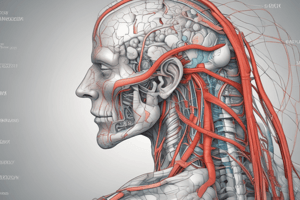Podcast
Questions and Answers
What primarily establishes the resting membrane potential of a cell?
What primarily establishes the resting membrane potential of a cell?
- The passive and active redistribution of ions (correct)
- The generation of action potentials
- The equal distribution of ions across the membrane
- The rapid influx of calcium ions
What occurs when the membrane potential is depolarized beyond the threshold?
What occurs when the membrane potential is depolarized beyond the threshold?
- The initiation of hyperpolarization
- The closing of sodium channels
- The generation of an action potential (correct)
- The inactivation of potassium channels
How does myelin affect the conduction of action potentials?
How does myelin affect the conduction of action potentials?
- It blocks the sodium potassium pump
- It decreases the speed of action potentials
- It insulates neurons preventing depolarization
- It speeds up the conduction of action potentials (correct)
What happens to neurotransmitters when an action potential reaches the presynaptic element?
What happens to neurotransmitters when an action potential reaches the presynaptic element?
What determines the likelihood of a neuron firing an action potential?
What determines the likelihood of a neuron firing an action potential?
What is an inhibitory post-synaptic potential (IPSP)?
What is an inhibitory post-synaptic potential (IPSP)?
How are neurotransmitters removed from the synaptic cleft?
How are neurotransmitters removed from the synaptic cleft?
What effect does the entry of positively charged ions have on the membrane potential?
What effect does the entry of positively charged ions have on the membrane potential?
Flashcards
Resting membrane potential
Resting membrane potential
The electrical potential difference across a neuron's membrane when it is not transmitting a signal. It's maintained by the uneven distribution of ions, primarily potassium (K+) and sodium (Na+) due to the sodium-potassium pump.
Action potential
Action potential
A rapid, short-lasting change in the membrane potential of a neuron. It's a signal that travels down the axon to communicate with other neurons.
Depolarization
Depolarization
The process where the membrane potential becomes less negative, increasing the likelihood of an action potential.
Hyperpolarization
Hyperpolarization
Signup and view all the flashcards
Myelin
Myelin
Signup and view all the flashcards
Neurotransmitters
Neurotransmitters
Signup and view all the flashcards
Post-synaptic potentials (PSPs)
Post-synaptic potentials (PSPs)
Signup and view all the flashcards
Neurotransmitter inactivation
Neurotransmitter inactivation
Signup and view all the flashcards
Study Notes
Resting Membrane Potential
- Established by passive and active ion redistribution.
- Ions are unevenly distributed across the membrane, creating a charge separation (inside more negative).
- Passive: Cell membrane is mostly impermeable to ions at rest, but specialized channels allow ion passage (e.g., potassium).
- Active: Sodium-potassium pump actively moves sodium ions out and potassium ions in, requiring ATP.
Action Potential Generation
- Initiated when the membrane potential depolarizes beyond a threshold.
- Neurons have ion channels that open in response to membrane potential changes, some opening with depolarization.
Depolarisation and Hyperpolarisation
- Depolarization: Membrane potential becomes less negative due to positively charged ion entry.
- Hyperpolarization: Membrane potential becomes more negative due to negatively charged ion entry.
Myelin and Action Potential Conduction
- Myelin speeds up action potential conduction.
- Myelinated axons conduct action potentials faster than unmyelinated ones.
Neurotransmitter Release
- Action potential arrival at the presynaptic terminal triggers calcium channel opening.
- Calcium influx causes neurotransmitter-containing vesicles to fuse with the plasma membrane and release their contents into the synaptic cleft.
- Vesicles dock and fuse with presynaptic membrane for content release.
Postsynaptic Potentials
- Postsynaptic potentials determine the likelihood of an action potential in the postsynaptic neuron.
Synaptic Activation and Action Potential Likelihood
- Excitatory postsynaptic potential (EPSP): Positively charged ion entry causes depolarization, increasing action potential likelihood.
- Inhibitory postsynaptic potential (IPSP): Negatively charged ion entry causes hyperpolarization, decreasing action potential likelihood.
Neurotransmitter Inactivation
- Reuptake: Neurotransmitters are removed from the synaptic cleft.
- Breakdown: Neurotransmitters are broken down, products may be transported back into presynaptic or glial cells.
Studying That Suits You
Use AI to generate personalized quizzes and flashcards to suit your learning preferences.
Description
Explore the essential concepts surrounding resting membrane potential and action potential generation in neurons. Learn about ion redistribution, depolarization, hyperpolarization, and the role of myelin in facilitating action potential conduction. Test your knowledge of these critical processes in neurophysiology.




